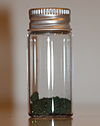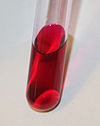Fuchsine
 |
|||
|
|||
| Names | |||
|---|---|---|---|
|
IUPAC name
4-[(4-Aminophenyl)-(4-imino-1-cyclohexa-2,5-dienylidene)methyl]aniline hydrochloride
|
|||
| Identifiers | |||
|
632-99-5 |
|||
| 3D model (Jmol) | Interactive image | ||
| ChEBI |
CHEBI:87665 |
||
| ChEMBL |
ChEMBL1979636 |
||
| ChemSpider |
10468578 |
||
| ECHA InfoCard | 100.010.173 | ||
| RTECS number | 8053-09-6 | ||
| UNII |
8UUC89LHB2 |
||
|
|||
|
|||
| Properties | |||
| C20H19N3·HCl | |||
| Molar mass | 337.86 g/mol (hydrochloride) | ||
| Appearance | Dark green powder | ||
| Melting point | 200 °C (392 °F; 473 K) | ||
| 2650 mg/L (25 °C (77 °F)) | |||
| log P | 2.920 | ||
| Vapor pressure | 7.49×10−10 mmHg (25 °C) | ||
|
Henry's law
constant (kH) |
2.28×10−15 atm⋅m3/mole (25 °C) | ||
|
Atmospheric OH rate constant
|
4.75×10−10 cm3/molecule⋅sec (25 °C) | ||
| Hazards | |||
| Main hazards | Ingestion, inhalation, skin and eye contact, combustible at high temperature, slightly explosive around open flames and sparks. | ||
| NFPA 704 | |||
|
Except where otherwise noted, data are given for materials in their standard state (at 25 °C [77 °F], 100 kPa).
|
|||
|
|
|||
| Infobox references | |||
Fuchsine (sometimes spelled fuchsin) or rosaniline hydrochloride is a magenta dye with chemical formula C20H19N3·HCl. There are other similar chemical formulations of products sold as fuchsine, and several dozen other synonyms of this molecule.
It becomes magenta when dissolved in water; as a solid, it forms dark green crystals. As well as dying textiles, fuchsine is used to stain bacteria and sometimes as a disinfectant. In the literature of biological stains the name of this dye is frequently misspelled, with omission of the terminal -e, which indicates an amine. American and English dictionaries (Webster's, Oxford, Chambers, etc.) give the correct spelling, which is also used in the literature of industrial dyeing. It is well established that production of fuchsine results in development of bladder cancers by production workers. Production of magenta is listed as a circumstance known to result in cancer.
Fuchsine was first prepared by August Wilhelm von Hofmann from aniline and carbon tetrachloride in 1858.François-Emmanuel Verguin discovered the substance independently of Hofmann the same year and patented it. Fuchsine was named by its original manufacturer Renard frères et Franc, is usually cited with one of two etymologies: from the color of the flowers of the plant genus Fuchsia, named in honor of botanist Leonhart Fuchs, or as the German translation Fuchs of the French name Renard, which means fox. An 1861 article in Répertoire de Pharmacie said that the name was chosen for both reasons.
...
Wikipedia



